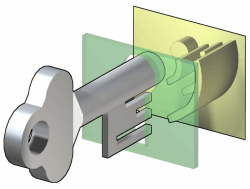Warded lock
|
|
A warded lock is a type of lock that uses a set of obstructions, or wards, to prevent the lock from opening unless the correct key is inserted. The correct key has notches or slots corresponding to the obstructions in the lock, allowing it to rotate freely inside the lock. Warded locks are commonly used in inexpensive padlocks, cabinet locks, or other low-security applications, since they are among the most easily circumvented by lock picking. A well-designed skeleton key can successfully open a wide variety of warded locks.
Warded_with_key.png
Warded_unlocked.png
History
The warded lock is one of the most ancient lock designs still in modern use. It is thought to have been developed in ancient Rome.
Design
In the most basic warded lock, a set of obstructions, often consisting of concentric plates protruding outwards, blocks the rotation of a key not designed for that lock. Warded locks may have one simple ward, or many intricate wards with bends and complex protrusions; the principle remains the same. Unless the notches or slots in the key correspond to the wards in the lock, the key will strike an obstruction and will not turn.
A cylindrical post is typically located in the center of the lock. Its purpose is to provide a point of leverage for rotating the key, and to help correctly align the key with the wards. The key has a corresponding hole which fits over the post.
When the correct key is inserted, it will clear the wards and rotate about the center post. The key may then strike a lever, activating a latch or sliding bolt, or it may itself push against the latch or bolt. In a double action lever lock, the key may additionally push against a spring-loaded lever which holds the sliding bolt in place.

